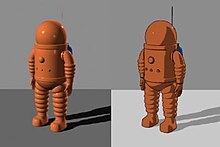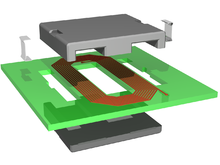Non-photorealistic rendering: Difference between revisions
→Notable films and software: wikilink formatting |
|||
| Line 3: | Line 3: | ||
==History== |
==History== |
||
The term "non-photorealistic rendering" was probably coined by [[David Salesin]] and [[Georges Winkenbach]] in a 1994 paper.<ref>''Computer-Generated Pen-and-Ink Illustration''", by Winkenbach and Salesin, SIGGRAPH 94</ref> Many researchers find the terminology to be unsatisfying; some of the criticisms are as follows: |
The term "non-photorealistic rendering" was probably coined by [[David Salesin]] and [[Georges Winkenbach]] in a 1994 paper.<ref>''Computer-Generated Pen-and-Ink Illustration''", by Winkenbach and Salesin, SIGGRAPH 94</ref> Many researchers find the terminology to be unsatisfying; some of the criticisms are as follows:{{fact}} |
||
* The term "[[photorealism]]" means something different to graphics researchers than it does to artists, who are the target consumers of NPR techniques. For artists, it refers to a school of painting that focuses on reproducing the effect of a camera lens, with all the distortion and hyper-reflections that it involves. For graphics researchers, it refers to an image that is visually indistinguishable from reality. In fact, graphics researchers lump the kinds of visual distortions that are used by photorealist painters into non-photorealism. |
* The term "[[photorealism]]" means something different to graphics researchers than it does to artists, who are the target consumers of NPR techniques. For artists, it refers to a school of painting that focuses on reproducing the effect of a camera lens, with all the distortion and hyper-reflections that it involves. For graphics researchers, it refers to an image that is visually indistinguishable from reality. In fact, graphics researchers lump the kinds of visual distortions that are used by photorealist painters into non-photorealism. |
||
* Describing something by what it is not is problematic. Equivalent comparisons might be "non-elephant biology", or "non-geometric mathematics". NPR researchers have stated that they expect the term will disappear eventually, and be replaced by the more general term "computer graphics", with "photorealistic graphics" being used to describe traditional computer graphics. |
* Describing something by what it is not is problematic. Equivalent comparisons might be "non-elephant biology", or "non-geometric mathematics". NPR researchers have stated that they expect the term will disappear eventually, and be replaced by the more general term "computer graphics", with "photorealistic graphics" being used to describe traditional computer graphics. |
||
Revision as of 13:03, 1 February 2014

Non-photorealistic rendering (NPR) is an area of computer graphics that focuses on enabling a wide variety of expressive styles for digital art. In contrast to traditional computer graphics, which has focused on photorealism, NPR is inspired by artistic styles such as painting, drawing, technical illustration, and animated cartoons. NPR has appeared in movies and video games in the form of "toon shading", as well as in scientific visualization, architectural illustration and experimental animation. An example of a modern use of this method is that of cel-shaded animation.
History
The term "non-photorealistic rendering" was probably coined by David Salesin and Georges Winkenbach in a 1994 paper.[1] Many researchers find the terminology to be unsatisfying; some of the criticisms are as follows:[citation needed]
- The term "photorealism" means something different to graphics researchers than it does to artists, who are the target consumers of NPR techniques. For artists, it refers to a school of painting that focuses on reproducing the effect of a camera lens, with all the distortion and hyper-reflections that it involves. For graphics researchers, it refers to an image that is visually indistinguishable from reality. In fact, graphics researchers lump the kinds of visual distortions that are used by photorealist painters into non-photorealism.
- Describing something by what it is not is problematic. Equivalent comparisons might be "non-elephant biology", or "non-geometric mathematics". NPR researchers have stated that they expect the term will disappear eventually, and be replaced by the more general term "computer graphics", with "photorealistic graphics" being used to describe traditional computer graphics.
- Many techniques that are used to create 'non-photorealistic' images are not rendering techniques. They are modelling techniques, or post-processing techniques. While the latter are coming to be known as 'image-based rendering', sketch-based modelling techniques, cannot technically be included under this heading, which is very inconvenient for conference organisers.
The first conference on Non-Photorealistic Animation and Rendering included a discussion of possible alternative names. Among those suggested were "expressive graphics", "artistic rendering", "non-realistic graphics", "art-based rendering", and "psychographics". All of these terms have been used in various research papers on the topic, but the term NPR seems to have nonetheless taken hold.
The first technical meeting dedicated to NPR was the ACM sponsored Symposium on Non-Photorealistic Rendering and Animation[2] (NPAR) in 2000. NPAR is traditionally co-located with the Annecy Animated Film Festival,[3] running on even numbered years. From 2007 NPAR began to also run on odd-numbered years, co-located with ACM SIGGRAPH.[4]
3D

Three-dimensional NPR is the style that is most commonly seen in video games and movies. The output from this technique is almost always a 3D model that has been modified from the original input model to portray a new artistic style. In many cases, the geometry of the model is identical to the original geometry, and only the material applied to the surface is modified. With increased availability of programmable GPU's, shaders have allowed NPR effects to be applied to the rasterised image that is to be displayed to the screen.[5] The majority of NPR techniques applied to 3D geometry are intended to make the scene appear two-dimensional.
For enhanced legibility, the most useful technical illustrations are not necessarily photorealistic. Non-photorealistic renderings, such as exploded view diagrams, greatly assist in showing placement of parts in a complex system.
2D
The input to a two-dimensional NPR system is most commonly an image; however, there are systems that take 3D geometry information as input and produce a 2D image or video as output. Again, many of the systems are intended to mimic a desired artistic style, such as watercolor, impressionism, or pen and ink drawing. Sketchy style is a rendering form that mimic hand-drawn graph primitive.
Users who are interested in having much more control in the NPR process may be more interested in interactive techniques. Many of these NPR systems provide the user with a canvas that they can "paint" on using the cursor — as the user paints, a stylized version of the image is revealed on the canvas. This is especially useful for people who want to simulate different sizes of brush strokes according to different areas of the image.
In contrast to the methods mentioned previously, another technique in NPR is simulating the painter's medium. Methods include simulating the diffusion of ink through different kinds of paper, and also of pigments through water for simulation of watercolor.
Notable films and software
This section lists some seminal uses of NPR techniques in films and software. See the article on cel-shaded animation for a list of uses of toon-shading in games and movies.
| Short films | ||
|---|---|---|
| Technological Threat | 1988 | Early use of toon shading together with Tex Avery-style cartoon characters. |
| Gas Planet | 1992 | Pencil-sketching 3D rendering by Eric Darnell. |
| Fishing | 2000 | Watercolor-style 3D rendering David Gainey. |
| RoadHead Snack and Drink |
1998 1999 |
Short films created with Rotoshop by Bob Sabiston. |
| Ryan | 2004 | Nonlinear projection and other distortions of 3D geometry. |
| The Girl Who Cried Flowers | 2008 | Watercolor-style rendering by Auryn. |
| Feature films | ||
| What Dreams May Come | 1998 | Painterly rendering in the "painted world" sequence. |
| Tarzan | 1999 | First use of Disney's "Deep Canvas" system. |
| Waking Life | 2001 | First use of rotoshop in a feature film. |
| A Scanner Darkly | 2006 | "a 15-month animation process" |
| Video games and other software | ||
| Jet Set Radio | 2000 | Early use of toon-shading in video games. |
| SketchUp | 2000 | Sketch-like modelling software with toon rendering. |
| The Legend of Zelda: The Wind Waker | 2002 | One of the most well-known cel-shaded games |
| XIII | 2003 | done as "comic"-like as possible |
References
- ^ Computer-Generated Pen-and-Ink Illustration", by Winkenbach and Salesin, SIGGRAPH 94
- ^ http://www.npar.org
- ^ http://www.annecy.org
- ^ http://www.siggraph.org
- ^ http://developer.amd.com/media/gpu_assets/ShaderX_NPR.pdf
Further reading
Some key papers in the development of NPR are:
- "Paint by Numbers: Abstract Image Representations", by Paul Haeberli, SIGGRAPH 90
- "Comprehensible rendering of 3-D shapes", by Saito and Takahashi, SIGGRAPH 90
- "Wet and Sticky: A Novel Model for Computer-Based Painting", by Tunde Cockshott, PhD Thesis, Glasgow University, 1991
- "Computer-Generated Pen-and-Ink Illustration", by Winkenbach and Salesin, SIGGRAPH 94
- "Interactive Pen-and-Ink Illustration", by Salisbury, Anderson, Barzel, Salesin, SIGGRAPH 94
- "Painterly Rendering for Animation", by Barb Meier, SIGGRAPH 96
- "A Non-Photorealistic Lighting Model For Automatic Technical Illustration", by Amy Gooch, Bruce Gooch, Peter Shirley.Elaine Cohen, SIGGRAPH 98
